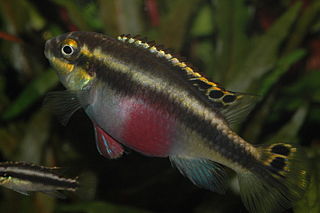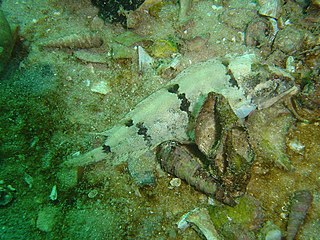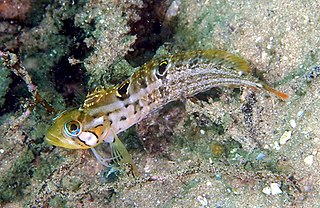This glossary of ichthyology is a list of definitions of terms and concepts used in ichthyology, the study of fishes.

Pelvicachromis is a genus of small, brightly coloured cichlids from tropical West Africa and Central Africa. They typically inhabit soft, acidic water.

Pelvicachromis pulcher is a freshwater fish of the cichlid family, endemic to Nigeria and Cameroon. It is popular amongst aquarium hobbyists, and is most commonly sold under the name kribensis, although it has other common names, including various derivatives and color morphs of the kribensis: krib, common krib, red krib, super-red krib and rainbow krib, along with rainbow cichlid and purple cichlid.

The broadfin sawtail catshark is a common species of catshark, part of the family Scyliorhinidae. It is found on or near the bottom at depths of 150–540 m (490–1,770 ft), from southeastern Japan to the East China Sea. A slender species growing to 68 cm (27 in) long, this shark is characterized by a fairly long, pointed snout, a series of indistinct, dark saddles along its back and tail, and a prominent crest of enlarged dermal denticles along the dorsal edge of its caudal fin. In addition, adult males have very long claspers that reach past the anal fin. The broadfin sawtail catshark is an opportunistic predator of bony fishes, cephalopods, and crustaceans, with immature and mature sharks being primarily piscivorous. It is oviparous and reproduces year-round.

The dwarf sawtail catshark is a little-known species of catshark, belonging to the family Scyliorhinidae, found exclusively in the deep waters off Luzon in the Philippines. Unlike other members of its genus, this slender, diminutive shark has a short, rounded snout and very short furrows at the corners of its jaws. It has indistinct darker saddles beneath each dorsal fin and two dark bands on the caudal fin, as well as a prominent crest of enlarged dermal denticles along the upper caudal fin margin.

Brachypterois serrulata, the sawcheek scorpionfish or pygmy lionfish, is a species of scorpionfish native to the northwestern Pacific Ocean.

Paracetopsis is a genus of whale catfishes found in tropical South America.

The zebra mbuna is a species of cichlid endemic to Lake Malawi in Africa. This species can reach a length of 11.3 cm (4.4 in). It feeds on aufwuchs, a surface layer of mostly algal material that grows on rocks. This cichlid is a mouthbrooder and the female broods the eggs in her mouth for about three weeks. This fish can sometimes be found in the aquarium trade.

The longfin trevally, also known as the longfin kingfish, longfin cavalla or armed trevally, is a species of inshore marine fish in the jack family, Carangidae. The species is common in tropical to subtropical waters of the Indo-Pacific, ranging from South Africa in the west to Japan in the east, typically inhabiting inshore reefs and bays. The species is easily distinguished by its elongate dorsal and anal fin lobes and filamentous dorsal rays, as well as its scaleless breast. Longfin trevally are pelagic predators, taking a variety of small fish, cephalopods and crustaceans, and reach sexual maturity at around 21 cm. The species has a maximum known length of 57 cm and weight of 3.5 kg. The longfin trevally has a very complex taxonomic history which is closely intertwined with another currently valid species, Carangoides ciliarius, which may yet prove to be synonymous. Longfin trevally are of minor importance to fisheries throughout their range and are considered good table fish, and are occasionally taken by anglers.
Pseudanthias heemstrai, the orange-headed anthias, Heemstra's anthias or redhead anthias is a species of marine ray-finned fish in the genus Pseudanthias, the subfamily Anthiinae of the family Serranidae, the groupers and sea basses. It is endemism to the Red Sea. It occasionally makes its way into the aquarium trade. It grows to a size of 13 cm in length.

Cephalopholis fulva, the coney or the butterfish, is a species of marine ray-finned fish, a grouper from the subfamily Epinephelinae which is in the family Serranidae which also includes the anthias and sea basses. It is found in the western Atlantic. It is associated with reefs and is a quarry species for commercial and recreational fisheries. It can be found in the aquarium trade.

Cephalopholis spiloparaea, known commonly as the strawberry hindstrawberry rock cod, strawberry cod or orange rock cod, is a species of marine ray-finned fish, a grouper from the subfamily Epinephelinae which is in the family Serranidae which also includes the anthias and sea basses. This fish occurs throughout the Indo-Pacific region.
Climacoporus navalis, the fleet klipfish, is a species of clinid found in subtropical waters of the Atlantic Ocean along the coast of South Africa where it can be found in tide pools. This species can reach a maximum length of 7 centimetres (2.8 in) TL. It is currently the only known member of its genus.

Clinus agilis, the agile klipfish, is a species of clinid found in subtropical waters of the Atlantic Ocean from Namibia to South Africa where it is commonly found in estuaries and tide pools. This species can reach a maximum length of 10 centimetres (3.9 in).
The phallic catshark is a little-known species of catshark, belonging to the family Scyliorhinidae. It is found on or near the ocean floor, in the deep waters off New Caledonia and Vanuatu. A slender species attaining a length of 46 cm (18 in), it is characterized by a long caudal fin bearing a crest of enlarged dermal denticles along the dorsal margin, and very long claspers in adult males. This shark is gray-colored, with four dark saddles along the back and tail.

Clinus venustris, the speckled klipfish, is a species of clinid that occurs in subtropical waters of the Atlantic Ocean from Namibia to South Africa where it is found in the subtidal zone as well as being a denizen of tide pools. This species can reach a maximum length of 12 centimetres (4.7 in) TL. and feeds primarily on amphipods, isopods, mysids, and echinoderms.

Epinephelus sexfasciatus, the sixbar grouper, sixbar rockcod or six-banded rockcod, is a species of marine ray-finned fish, a grouper from the subfamily Epinephelinae which is part of the family Serranidae, which also includes the anthias and sea basses. It is found in the Indo-Pacific region.
Pelvicachromis silviae is a species of cichlid in the genus Pelvicachromis. It is found in the Niger River, in the same region as congeners Pelvicachromis pulcher and Pelvicachromis taeniatus.
Trachurus delagoa, the African scad, is a species of jack mackerel from the family Carangidae which is found in the south western Indian Ocean.
Placidochromis boops is a species of deep-water African cichlid endemic to the southern portion of Lake Malawi. This species can reach a length of up to 11.2 centimetres (4.4 in) SL.


















